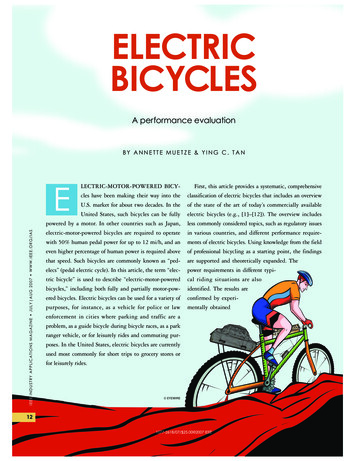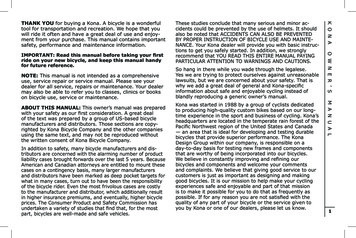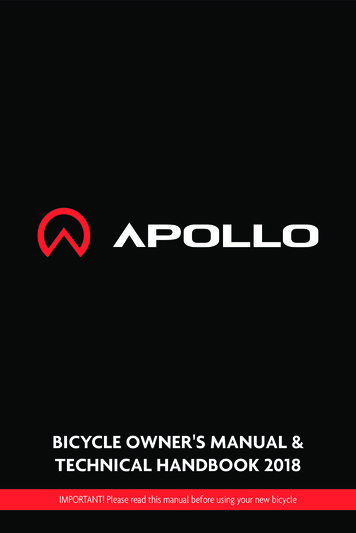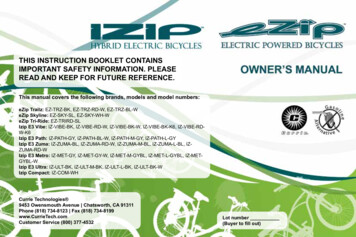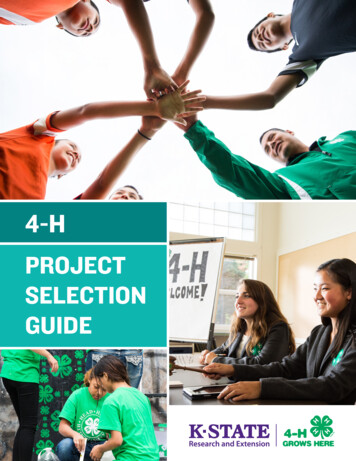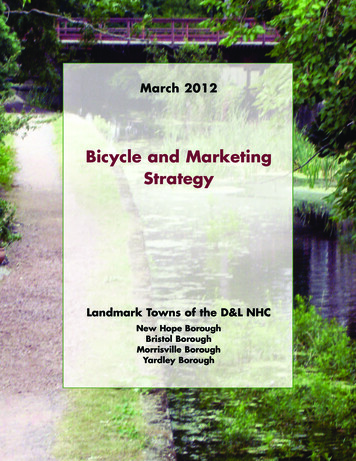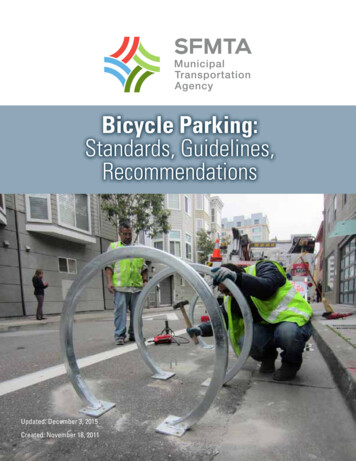
Transcription
A handbook forbicycle riders1
2
ContentsSection 1Section 2IntroductionWear the right gearPage 5Section 6Page 6Bicycle helmetsChoose the right clothingSection 3Choose the right bicycleand equipmentChoose the right bicycleChoose the best framePage 8Identification markingsLocksIf your bicycle is stolenInsuranceSection 7Section 8Responsible riding on the roadPage 21Avoiding and managing crashesPage 25Causes of crashesWhat to do in the case of a crashSection 9Page 12Servicing your bicycleRepairing puncturesSection 5 Keep your bicycle securePage 18Hazard perceptionIntersections, roundabouts and turningNegotiating heavy trafficChoose the right sizeCustom-made bicyclesComfortable ridingEssentials for your bikeOptional equipmentChild carrying devicesSection 4 Maintain your bicycleRide safelyPlan the safest routeCheck the weatherDrugs and alcoholFatigueRoad rules for bicycle ridersPage 27Special rules for bicycle ridersResponsibilities of bicycle ridersSection 10 PenaltiesPage 30Section 11 IndexPage 31Page 16This handbook is an interpretation of the law made easy to understand by using plainEnglish. Laws change often, so make sure you have the most recent handbookavailable on the RMS website at www.rms.nsw.gov.au3
4
IntroductionWelcome to A handbook for bicycle riders – a useful guide toriding your bicycle safely on NSW roads.Cycling is an active form oftransport for people of all ages– it’s healthy, environmentallyfriendly and enjoyable.The NSW Government is committed topromoting cycling as a transport choice.At Roads and Maritime Services,our aim is to improve cyclewayinfrastructure and promote cyclesafety. By working with local councils,schools, community groups and othergovernment departments, we hope tocreate a better future for cyclists.In A handbook for bicycle riders you’llfind valuable tips on road safety, bicyclemaintenance, road rules and the legalaspects of riding your bicycle.15
Wear the right gearReduce your risk of head injuryin the event of a bicycle crash –wear an approved helmet. Hard shell – a foam shell with a thickerplastic cover.Bicycle helmetsYour helmet must: Be approved and conform to Australianand New Zealand standards Be a good fit Have a number of ventilation holes oropenings Be layered with thick, energy absorbinghard foam Not hinder vision Be lightweight for comfort Have adjustable straps Not have been damaged or involved ina crash.When riding, you are required by law towear an approved bicycle helmet securelyfitted and fastened on your head.Look for the sticker certifying the helmetmeets Australian and New Zealandstandards (AS/NZS2063) displayed on thehelmet to ensure it has passed stringentsafety tests.62Protect your head – it’s the law.Choose the best helmetThere are three types of helmets: Soft shell – a foam shell with a fabriccover Micro shell – a foam shell with a thinplastic coverIt is recommended that you choose abrightly coloured helmet to heighten yourvisibility.
2Correctly fit your helmetA helmet must be correctly fitted tomaximise its effectiveness in theevent of a crash. Position the helmet on your head and tilt itforward until the front of the helmet is twofingers above the bridge of your nose. Fasten and straighten the helmet bucklesand straps and adjust for a snug fit. One finger should be able to fit between thebuckle and your chin while the helmet isfirmly in place on your head. Avoid wearing anything under the helmetsuch as a hat or beanie as this may affectthe correct fitting of the helmet on yourhead. It may also hinder ventilation causingyou to become dehydrated.Replace your helmetDamaged helmets can bedangerous. Replace your helmet if: The helmet has been damaged or involvedin a crash The helmet polystyrene is cracked The straps are worn or frayed The helmet does not properly fit your head.Choose the right clothingIncrease your visibilityWear bright clothes during the day anda reflective vest at night. If you don’thave a reflective vest, dress in coloursthat reflect the light from cars such aswhite or fluorescent green.Increase your comfortOn long journeys, consider wearingcycling pants and a bright colouredcycling jersey as these are made forcycling comfort.Stay coolSelect clothing that allows good airflowbetween fabric and skin – this will keepyou cool as you ride.Be prepared for bad weatherTake a good weatherproof jacket andwaterproof pants to help keep you dry incase of rain.Protect your eyesWear sunglasses or clear lens glassesto stop bugs, dirt and rain from flyinginto your eyes, particularly when you’reriding in the country. Sunglasses willalso protect your eyes from the glare.7
Choose the right bicycle and equipmentIt’s important to ensure yourbicycle suits your abilities and isroadworthy before you ride – foryour own comfort and becauseunder the law, a bicycle is alegitimate road vehicle.883Choose the right bicycleThere are four main categories ofbicycles: Road bike Hybrid Mountain bike BMXA road bike is suitable for riding on theroad, while a hybrid bike is good formultipurpose use. Mountain bikes arebest for off-road use and BMX bikes aredesigned for off-road courses and stunts.Choose the right sizeTo choose the best size bicycle, stand overthe bicycle with your feet firmly on the groundand measure the distance between thebicycle frame and your crotch.There should be a clearance of about threecentimetres for a road or hybrid bicycle and10 centimetres for a BMX or mountain bike.If you’re unable to put both heels on theground when doing this test, the bicycle is toobig for you. The bicycle will be unsafe anduncomfortableCustom-made bicyclesIf you decide to make your own bicycle usingspecialised or modified parts, or you modifyyour bicycle with better parts, you shouldconsult a qualified bicycle mechanic to ensureyour bicycle is safe before you ride.Aim for quality parts that have beenmanufactured to Australian Standardsidentified by an Australian Standards sticker.
3Some bicycle parts including brakes,gears, handlebars and forks may need tobe calibrated by a qualified bicyclemechanic. Check with your local bicyclestore for further advice.Comfortable ridingAdjust your seatSeat positioning is important for bothstability and comfort. If the seat height istoo low, you could experience sore knees.Position your seat at a height that allowsyou to bend your knee slightly when yourleg is in its most extended position.Always check your seat is properlysecure before going out on a ride –particularly after making any changes.Adjust your handlebarsWell-adjusted handlebars will allow you toconfidently mount, start off, steer, pedal,balance, ring the bell and stop.Handlebars can be adjusted on mostbicycles and should be adjusted so that yourarms are slightly bent and your body leansforward between the handlebars and theseat.The handlebars should be far enough forwardso you can balance your bodyweight betweenthe handlebars and the seat. Too muchpressure on the seat can cause back pain,while too much pressure on the handlebarscan cause neck, shoulder and wrist pain.After any adjustments, and before you go outriding, always check that your handlebarsare secure.Using the pedalsFor maximum comfort, wear shoes withflexible soles and ensure the widest part ofyour foot is over the pedal axle. Stiff soledshoes can make your feet sore. Wearingcycling shoes with cleats will also ensurecentralised pressure on the pedals.Essentials for your bikeLights and reflectorsreflectors to suit your needs. Pedal andwheel reflectors increase your visibility toother road users.By law, you must have your lights onbetween sunset and sunrise and in badweather.BrakesFront and rear working brakes will increaseyour ability to stop your bicycle suddenlyand safely.By law, your bicycle is required to have atleast one working brake.Bell or hornA bell or horn enables you to let pedestriansand other cyclists know you’re around – thisis particularly useful when overtaking.Under the NSW Road Rules, your bicyclemust be fitted with at least one working bellor horn, or a similar warning device.Good quality lights and reflectors willincrease your visibility on the road.Light emitting diode (LED) lights areextremely bright and require less energy topower, making your batteries last longer.Traditional incandescent lights require regular Tyresbulb changes and may not be as bright asTyres should be appropriate to the size ofLED lights.your bicycle and inflated to the pressure asHuman powered bicycle lights do not require listed on the tyre wall.batteries, but most will not operate withoutIf you need to replace your tyre or tyre tube,you physially pedalling. This means thatyou should purchase a replacement thatwhen you’re stopped, you could be difficultmatches the original. If you’re unsure ofto see.which tyre or tube to choose, consult yourlocal bicycle shop.It’s best to seek expert advice on lights and9
3Choose the right bicycle and equipmentOptional extras for your bikeOptional extras for your bikeTool kitIt’s advisable to keep a well maintained bicycletool kit with you when you are out riding – you’llfind it invaluable in the case of a breakdown oremergency.A standard bicycle tool kit can bepurchased from your local bike shop andshould include: Tyre levers Spare tube Patch kit Multi-purpose tools or wrenches.PanniersPanniers are saddlebags thatallow you to comfortably andsafely transport loads on theside of your bicycle.Panniers evenly distribute theweight, helping you to maintain yourcentre of gravity while riding. You’llfind using them safer and morecomfortable than carrying items onthe handlebars, in a backpack orother parts of the bicycle.10Overloading your bicycle, whether usingpanniers or not, will affect the balance andbraking ability of your bike, making it moredifficult for you to control and stop.Bicycle pumpA bicycle pump fixed to your bicycle frame willbe very useful. Pumps with a collapsible handleare quick, easy to use and handy if you need toinflate a tube mid-ride.Foot and electric bicycle pumps are also goodto keep at home to inflate tyre tubes quicklyand easily.You may find carrying a pressure gauge inyour tool kit worthwhile so that you canensure your tyres are filled to the correct airpressure.Rear-view mirrorA rear-view mirror may help you toidentify hazards as they approach.First aid kitYou should consider carrying a good first aidkit when cycling that contains: A bandage Antiseptic cream or fluid Band aids Sun cream Lip balm.
3Bicycle computerA bicycle computer is helpful if you areinterested in calculating your speed,distance travelled or kilojoules burnt offduring your exercise.Bicycle computers vary in price, rangingfrom simple models that calculate basicinformation, to more expensive modelsthat calculate kilojoules burnt and otheradvanced statistics.Bike rack plateWhile a rear car bicycle rack makes it quickand easy to transport your bike by car,racks can obscure your car rear numberplate. If this happens, you’ll need topurchase a special bike rack plate for yourcar and fix it to the number plate holder onthe bicycle rack. Penaltiesapply for obscuring the number plate.For safety, and to protect your bike,always check that your bicycle is correctlyfitted to the bike rack and firmly fixed inplace before you start driving.For more information on ordering bike rackplates, phone the RMS on 13 22 13 or visitthe website at www.rms.nsw.gov.au.Child carrying devicesThere are a number of child carryingdevices available for bicycles, including arear seat child carrier and a behind bicyclechild trailer.It is important to check that buckles andclips are correctly fastened and strapsadjusted to comfortably restrain the childin the rear seat carrier.When using a behind bicycle child trailer,ensure that restraints are used and thetrailer is correctly fitted to the main bicycleframe.Young children must wear a helmetwhenever riding – whether sitting in a childcarrier or a cycle trailer.Please consider the stage of developmentof your child before placing a helmet onthe child’s head for long periods.Do not ride with children inheavy traffic or alongmotorways or freeways. Ifpossible, keep to quiet roadsand use cycleways or off-roadbicycle paths.11
Maintain your bicycleKeep your bicycle in good condition.Keeping your bike in good condition willenhance your cycling experience and thelongevity of your bike. Bicycles shouldalways be well maintained and in goodworking order.You should carry out a 3-minute checkevery time you ride your bike. You shouldalso perform regular maintenance checksand have your bicycle professionallyserviced at regular intervals, at leastonce a year, to ensure it is in the safestcondition.124If you discover one or more of yourbicycle parts is damaged or requiresrepair, ensure the repair has beencompleted by a qualifiedbicycle mechanic and is safe to usebefore you continue riding.Servicing your bicycleThe 3- minute check1 . Tyres should feel very firm to touch. Thecorrect pressure is written on thesidewall of each tyre.2 . Check the seat is at the correct heightand the seat post is tightly inserted atleast 5cm into the frame.3. Lift the handlebars, spin the frontwheel, apply the brakes and checkthat the: Wheel is properly secured in the forks Quick release levers are secure Wheel rotates freely without rubbingon the brakes Gears and brakes operate smoothlyand directly.4. Lift the seat, turn the pedals, spin therear wheel, operate the gears andbrakes, and apply the above four stagetest again.
4Weekly maintenance Clean and lubricate the chain Check wheel spokes and eyelets for rustor damage Check tyre pressures.Monthly maintenance Check tyres for wear or splits in the rubber Check wheel bearings, chain, gearcluster (back chain wheels), chain rings(front cogs) and head stem (handlebars).Annual maintenance Check the frame Remove handlebar tape to check for rustand weaknesses When purchasing new tyres, make surethey are the right size When replacing the chain, also changethe gear cluster as both generally wearout evenly.13
4Repairing puncturesRepairing puncturesWhen replacing a tube:1. With rear wheels, ensure the chain is8. Roughen the surface of the punctured16. When the tube is bedded into the rimplaced on the smallest cog before removing.2. Unhitch the brake from the wheel.area using the metal scraper provided withyour puncture kit or use sandpaper.well, firmly push the tube valve to seat itproperly.3. Ease the wheels out, never forcing it.9. Glue the roughened area and leave the17. Starting at the valve, begin rolling theglue to cure for at least two minutes.outside wall of the tyre onto the rim. Do notuse the levers to do this. Keep checking thatthe tube is not being pinched by the tyre.4. Ensure the tyre is fully deflated bydepressing the small pin on the tyre valve.5. Pinch the tyre walls firmly together allthe way around the tyre to work the tyrebead away from the rim.6. Use tyre levers to remove the tyre byhooking one lever between the rim and thetyre wall on one side, Hook the other level inat the same point and run it around the rimto release the tyre, Make sure the levers donot pinch the inner tube. You can removethe tube with half the tyre off the rim. You donot need to remove the whole tyre.7. Lift the valve out of the hole. Removethe tube then partially inflate it to find thepuncture location. Fell around the tube forescaping air and listen for the ‘hissing’sound. Alternatively, you can place the tubein water and watch for bubbles to locate thehole. Make sure the tube is dry before youcontinue the repair.1410. Check inside and outside the tyre for thepossible cause of the puncture and removeany debris. Also check for cuts through thetyre.11. Take a patch from your repair kit andremove the metal foil backing. Firmly pressthe patch onto the glued surface.18. If the tyre is a tight fit, start back at thevalve and roll/pinch the rubber in a forwardmotion to increase the amount of stretch inthe tyre.19. Once the tyre is on, inflate the tube thenspoke vents and is centred into the rim well.check the valve for any further air leaks andcheck that there are no bulges in the tyre.13. If the tyre has been completely removed,20. For a rear wheel replacement, place the12. Check that the rim tape covers themake sure that the tread pattern is facing inthe correct direction. Place one tyre wallover the rim edge on one side, keeping thetyre tread in the correct directional pattern.wheel back by making sure the skewer isbetween the top and bottom chain and thetop chain is engaging the small cog on thecluster. Flip the skewer over to lock.14. Partially inflate the tube in order to21. Ensure the wheel is correctly centred inunfold any creases and insert the tube intothe tyre.22. Finally, hook the brakes and spin the15. Begin at the valve rolling the partiallywheel to check it is rolling smoothly.inflated tube into the well of the rim.the fork ends.
15
Keep your bicycle secureRecord identification markingsMost bicycles are stamped with a uniqueidentification number, also known as aserial number. You’ll usually find thenumber on the underside of the bicycleframe. It’s wise to keep a note of thisnumber in case your bicycle is lost orstolen.If your bicycle does not have a serialnumber, you could engrave your ownidenttification number and record thedetails.There are several other easy measuresyou can take to assist the Police if yourbicycle is lost or stolen:165 Note features such as colour, stickers,engravings and any unique aspect ofyour bicycle Take a photo of you and your bicycle.Lock it up You can avoid theft by securing yourbicycle when it is unattended. Carry a good bicycle lock and ensure thatyou secure the wheels and the frame. Try to use bicycle parking facilities whenthey are available. If you are leaving your bicycle for a longerperiod of time, consider removing thefront and rear wheels and pairing thesewith the frame. Always lock your bicycleto a permanent fixture that cannot bemanipulated to remove the lock. Remove all non-fixed items, i.e. lights,panniers, pumps etc.
5If your bicycle is stolenYou should report the theft to Policeimmediately or as soon as possible.Provide the Police with all therelevant details including anyidentifying features along with yourphotograph of you and your bike.Contact your local Police Station onthe number provided in thephonebook or phone the PoliceAssistance Line on 131 444.InsuranceAs a bicycle rider, you are not requiredto take out compulsory third partyinsurance on your bicycle like motorvehicles.However, you should be aware that ifyou have a crash involving anotherperson or that person’s property, youmay be financially liable for any injuryor damage you cause.Bicycle insurance is available toprotect yourself against liability andto protect your investment.Check with your insurance companyor contact Bicycle NSW.17
Ride safelyThe quickest route maynot be the safest. Try to stay upright and steer with yourarms rather than leaning into cornerswith your hips.Plan the safest route Take corners slower - wet ridingsurfaces reduce traction between thetyres and the surface.Before you set out, plan the routethat provides the safest roadconditions.Maximise your use of off-road and onroad bicycle lanes, and roads that havelow traffic volumes and speeds.Check the weather186When you’re riding a bicycle, the weathercan affect your safety and those aroundyou. If possible, get a forecast for the dayahead before cycling. If you find yourselfriding in poor conditions, keep thefollowing advice in mind:Riding in the rain Use your front and rear lights and weara reflective vest to make yourselfvisible to other traffic when riding indark, wet and slippery conditions. Apply the back brake smoothly andprepare yourself well in advance beforeentering a corner. Using the front brakeonly in a sudden stop has the potential tosend you over the handlebars. Avoid hazards such as potholes and stormwater grates. If you’re riding along a poorly drainedroad, avoid water channels by movingtowards the centre of your lane – butremember to look over your shoulderand give a hand signal before doing so.Move back to the left of the lane onceyou have passed the hazard or when it issafe to do so. Wear bright waterproof clothing.
6Know when it’s not safeDrugs and alcoholDrugs and/or alcohol can inhibit your abilityto respond quickly and safely in ahazardous situation. Riding a bicycle underthe influence of drugs or alcohol is illegaland dangerous for you and those aroundyou.Prescription drugsPrescription drugs can cause you to feeldrowsy and may slow your reaction time.Medicines that may affect your ability to ridesafely include: Some painkillers Some medicines for blood pressure,nausea, allergies, inflammation and fungalinfections Tranquillisers, sedatives and sleeping pills Some diet pills Some cold and flu medicines.You can reduce your risk by: Reading the label of any medicine youtake Not cycling after taking any medicationthat warns of an effect Not taking someone else’s medication, evenif you know the person Asking your doctor if in doubt.AlcoholAlcohol is a depressant that reducesyour ability to cycle safely because it: Slows the brain’s function, reducingyour ability to respond to situations,make decisions or react quickly. Reduces your ability to judge distance andthe speed of other road users. Makes it harder to do more thanone thing at a time. Affects your sense of balance andconcentration. Makes you sleepy.If you are going out drinking, it's safest toarrange a lift home by taxi or a car drivenby a non-drinker. Leave your bike at home.The safest BloodAlcohol Concentrationfor any road user iszero.
6FatigueFatigue is a term used to describe thefeeling of being ‘sleepy’, ‘tired’ or‘exhausted’. It’s your body’s way of tellingyou that you need sleep.While many people think fatigue onlyaffects drivers of cars and motorcycles,fatigue can also affect bicycle riders. Forbicycle riders, the problem with fatigue isthat it severely reduces yourconcentration and judgement and slowsdown your reaction time.Warning signs of fatigue Yawning Poor concentration Tired or sore eyes Restlessness Drowsiness Slow reaction Boredom Feeling irritable.20If you are experiencing any of thewarning signs, you may be sufferingfrom fatigue. For safety, delay yourbicycle ride until the symptomsdisappear.Useful tips for managing fatigue Drink plenty of water to keep hydrated Avoid too much coffee or sweet softdrinks Stay away from alcohol at all costs Eat small amounts of simple foodsfrequently such as fruit, nuts, a mueslibar or a small chocolate bar Avoid fatty foods and large mealsbefore or during a ride In winter, don’t make yourself too snugand warm – it’s good to be a little cool.Fatigue on the roadIf you feel fatigue while you’re outcycling, pull to a safe area on the side ofthe road and have a rest. If possible,discontinue your ride.
Responsible riding on the roadIt’s important that you don’trush into cycling. Giveyourself plenty of time tounderstand the road rulesand gain riding experiencebefore you ride in traffic.If you are a new rider or have purchased anew bike, it’s a good idea to find a spaceaway from traffic where you can practiseand build your confidence before you taketo the road.Hazard perceptionSee road hazards (pedestrians, motorists,other bicycle riders and the roadenvironment, eg opening doors, potholes,and grates).Thinkabout what might happen andanticipate how to avoid a problem.Do what you feel will ensure your safety.Check for hazardsMaximise your safety when riding byconstantly assessing your environment forany hazards that may cause a crash.Scan the road for holes, gaps, unevensurfaces, debris and regularly look overyour shoulder to check what is beside andbehind you. Do not wear headphoneswhen riding. You must be able to hearpotential hazards so you can reactquickly.Avoid blind spotsA blind spot is an area outside a motorvehicle that cannot be seen in the rear orside mirrors of the vehicle. When riding intraf, it is important to increaseyour visibility bykeeping away frommotor vehicleblind spots.blind spotblind spotmirrorsview721
7Anticipate vehicle movementWatch other road users – look at themovement of vehicle wheels, increases ordecreases in speed, brake lights and theuse of indicators that signal a change ofdirection.Make eye contact with other road users andavoid riding alongside a motor vehicle forlonger than required.StoppingWhen you need to stop, apply your backbrake initially and then your front so thatyour bicycle comes to a gentle halt. Asudden stop could send you over thehandlebars and cause an injury.Travelling behind a carYou must not ride your bicycle within twometres of the rear of a moving motor vehiclecontinuously for more than 200 metres.Intersections, roundaboutsand turningTraffic light loopsMost traffic lights in NSW are controlled byloops. These are embedded in the roadsurface close to the stop line at a signalisedintersection. Loops operate through amagnetic wave. When a car disrupts thewave, the signal detects that a car is at thelights.22Responsible riding on the roadSometimes bicycles do not trigger theloop to change the lights, simply becausethey do not contain as much metal ascars.To make sure the loop detects yourpresence, try to position your bicycle atthe sensitive points, usually in the centreof the square loop.Multi-lane roundaboutsYou should assess your own skill levelbefore attempting to travel through amulti-lane roundabout. If you don’t feelcomfortable negotiating a multi-laneroundabout, take a different route.Turning right at multi-lane roundaboutscan be dangerous for bicycle riders –particularly if you are unfamiliar with thearea or if there is heavy trafffic.You can make a right turn in one of twoways: Use the outer left lane, giving way ateach exit to all traffic exiting theroundabout Use the inner right lane and complete theturn in the same way a car would do.IntersectionsBefore you negotiate an intersection, try tomake eye contact with drivers who aregiving way. If you do not see their eyes lookat you, it is unlikely they have seen you.Turning rightTo ensure a safe right turn, look at thetraffic around you then indicate and turnwhen the traffic is clear. Make sure youlook over your shoulder to identifypotential hazards beside or behind youbefore making the turn.
7Hook turnsWhen you need to turn right in heavy traffic,you may find it useful to make a hook turn.A hook turn is made in three stages, usingthe left land to turn right.A. Position your bicycle to the far left side ofthe road then proceed into theintersection, keeping clear of any markedcrossings.B. Wait near the far left side of theintersection; giving way to vehiclestravelling straight through the intersection.If there are traffic lights, wait until thelights on the road you are entering turngreen.C. Proceed when it is safe and legal.Some intersections provide a hook turnstorage box and you must use this facility.At some intersections, bicycle riders areprohibited from making hook turns. A ‘NoHook Turn by Bicycles’ sign will bedisplayed.Negotiating heavy trafficAvoid riding beside heavyvehicles. Slow or stop to allowthem to pass, then safelycontinue your journey.Freeways and motorwaysBicycle storage areasFreeways and motorways carry largevolumes of traffic with multiple high-speedtraffic lanes in each direction. If you ride abicycle along a freeway or a motorway, youmust obey the law and only ride on theshoulder.Some signalised intersections may havebicycle storage areas. These are paintedareas on the road in front of the stop line thatallow you to wait at traffic lights in safety.You can enter these areas from thepreceding bicycle lane moving to the far leftor right to make your left or right turn. Youmust wait for the green signal beforeproceeding and follow the arrows on theroad.It is essential to take good care when ridingalong the shoulders of freeways andmotorways – particularly when approachingand crossing access ramps used by bothbicycles and vehicles. Be aware that youmay not be able to use all sections of thefreeway or motorway. Check you routebefore starting your journey.Freeway/motorway crossing pointsIf you ride your bicycle on freeways andmotorways, look for and, whenever possible,use designated signposted bicycle crossingareas.Be aware that vehicles are generallytravelling fast, so make sure you allow morespace before crossing.Correct hook turn with storage boxUsing a bicycle storage areaUsing a bicycle storage area23
7Heavy vehiclesAs a bicycle rider you should beparticularly aware of heavy vehiclesincluding buses and trucks as they posegreat risk to your safety. The size andweight of these vehicles results in manyblind spots and they need more room toturn and brake.Remember, if you can’t see the driver,they can’t see you.When heavy vehicles pass you at highspeed, be aware that the wind will affectyour stability and control of your bicycle.Rail and tram tracksCheck both ways twice and listen foroncoming trains/trams before youcross a track.Observe directions given by flashing lightsor boom gates warning you of anoncoming train.To ride safely over tracks, approach at aright angle to avoid your wheels gettingtrapped.If the crossing is too difficultto ride over, dismount andwalk your bicycle.24
Avoiding and managing crashesPractising safe cycling willhelp you respond correctlyto hazardous situations.As a bicycle rider, you have greaterexposure when travelling on the road thandrivers in motor vehicles. It’s mostimportant to be alert to all traffic andhazards and be capable and competentwhen riding.Causes of crashesTimes of crashesMost crashes involving bicycle riders occuron weekdays between 4pm and 6pm. Atthis time of day, the vision of all road userscan be impaired due to the setting sun,heavy
roadworthy before you ride - for your own comfort and because under the law, a bicycle is a legitimate road vehicle. Choose the right bicycle . There are four main categories of bicycles: Road bike Hybrid Mountain bike BMX A road bike is suitable for riding on the road, while a hybrid bike is good for multipurpose use.
